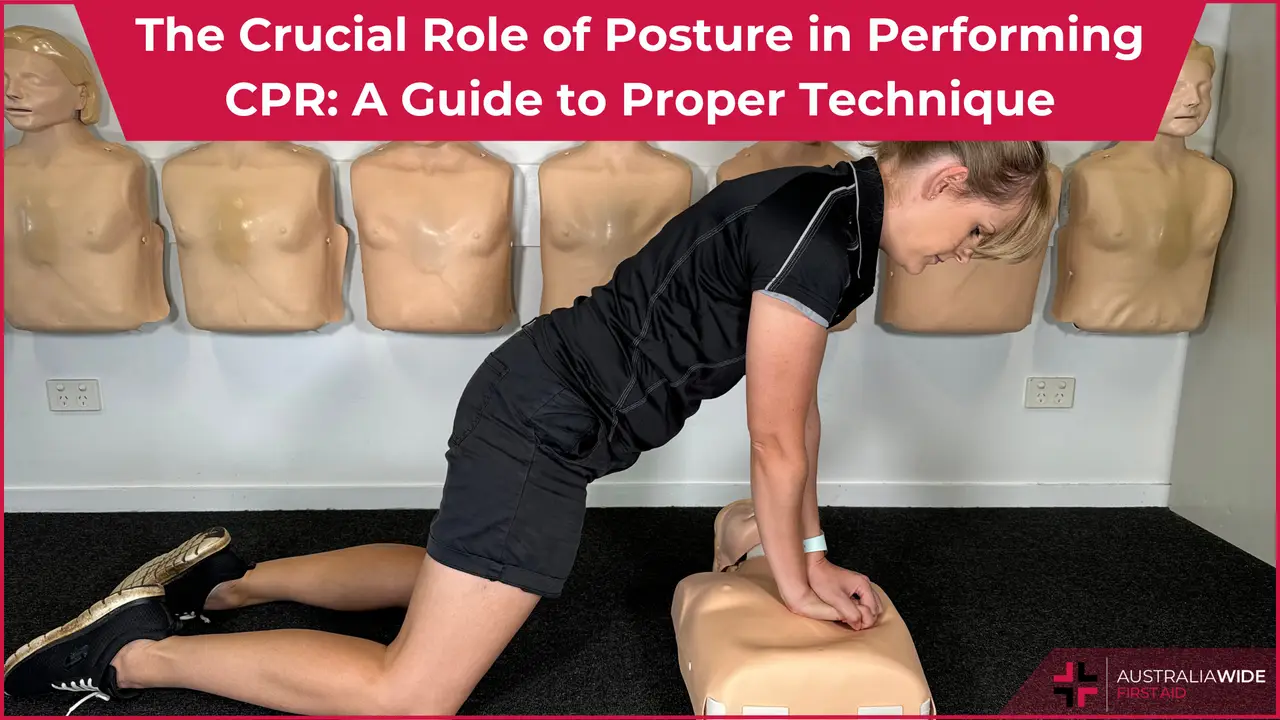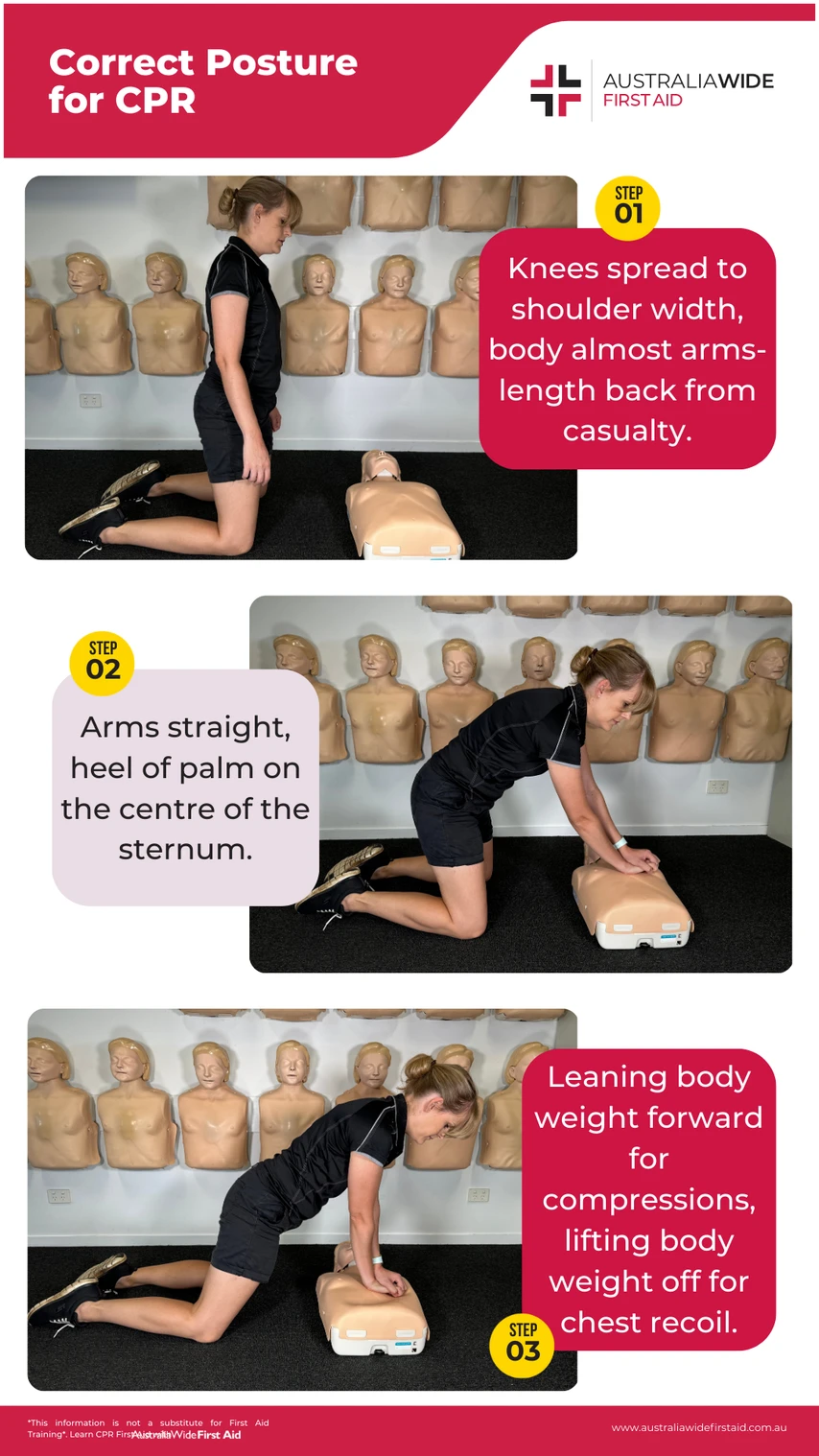Correct Posture When Performing CPR


Cardiopulmonary resuscitation (CPR) is a critical lifesaving skill that can significantly improve the chances of survival for individuals experiencing cardiac arrest.
While many people are trained in CPR techniques, the importance of proper posture during CPR cannot be overstated.
Correct posture not only enhances the effectiveness of chest compressions but also minimizes the risk of injury to both the rescuer and the victim.
The following guidance is assuming that the casualty is an adult, lying flat on the floor.
The effectiveness of CPR hinges on the ability to provide adequate chest compressions to maintain blood flow to vital organs.
Proper posture plays a pivotal role in achieving sufficient depth and rate of compressions, ensuring optimal circulation and oxygenation to the brain and other organs.
Additionally, maintaining the correct posture reduces fatigue and allows the rescuer to perform CPR more effectively for an extended period if needed. Poor posture may result in injuries, especially if you are performing CPR for an extended period.
Kneel beside the victim, ensuring that your shoulders are in line with the casualty’s chest.
You should be a little less than arms-length away from the casualty. Not only does this allow you to use your body weight effectively for compressions, it also allows you to lower down to deliver rescue breaths without having to shuffle your body around or bend at an awkward angle.
Knees should be spread to shoulder width to help you maintain a stable and balanced stance, and to provide maximum leverage for chest compressions.
Place the heel of one hand (usually the dominant hand) on the centre of the casualty's chest, right on the middle of the sternum.
Ensure that the other hand is placed directly on top of the first hand. You may choose to interlock your fingers, have the hands flat, or have the upper hand supporting the wrist of the lower hand – whatever is most comfortable for you.
Note that the hands should be at right angles to the sternum, so that your fingers would be touching the casualty’s ribs. Be careful to not allow your hands to twist, or your fingers to palpate the liver/stomach at the lower end of the ribs.
Keep your arms straight and perpendicular to the victim's chest.
Position your shoulders directly above your hands to facilitate effective transfer of force during compressions.
Maintain a slight bend at the elbows to prevent hyperextension and reduce the risk of fatigue.
Ensure you are not using your arm or chest muscles for compressions – rather, you should use your body weight.
Keep your back straight and the torso aligned with your arms and hands.
Engage your core muscles to provide stability and support during chest compressions.
Avoid hunching or arching your back, as this can diminish the force applied to the chest.
Depress the casualty’s chest to a third of the chest depth with each compression, allowing for adequate recoil between compressions.
Ensure a compression rate of 100 to 120 compressions per minute, maintaining a steady rhythm.
Allow the chest to fully recoil after each compression to facilitate blood flow back to the heart.

Maintaining the correct posture is essential for performing effective CPR and maximizing the chances of survival for individuals experiencing cardiac arrest.
By following the guidelines outlined in this article, rescuers can ensure optimal positioning and technique for adult casualties, thereby enhancing the quality of chest compressions and minimizing the risk of injury.
Continuous training and practice are key to mastering proper CPR posture and improving overall proficiency in lifesaving interventions.
Our Pocket Mask Training online course gives you the knowledge you need to be able to effectively us a pocket mask or face shield during CPR. Being fully online means you can work through it at your own place, either at your desk at work or in the comfort of your own home. Read the texts, watch the videos, and answer the quiz questions - it's as easy as that! You'll also receive a Certificate of Completion at the end of the course - perfect to hand to your employer or put on your resume.

April 12, 2024
Cardiopulmonary resuscitation (CPR) is a critical lifesaving skill that can significantly improve the chances of survival for individuals experiencing cardiac arrest. While many people are trained in CPR techniques, the importance of proper posture during CPR cannot be overstated.

February 23, 2024
Despite its apparent simplicity, bystanders often delay providing CPR to people with special conditions such as those in wheelchairs. This delayed response may be due to a lack of knowledge on what to do in such situations or the perceived complexity of the procedure due to the casualty's condition. However, the CPR principle remains the same for all casualties, whether they are in wheelchairs or not.

November 1, 2023
In this spine-tingling journey of resuscitation, maintain your grim composure, for you tread the precipice between the realms of life and death. Whether you are a mere mortal or a master of the macabre arts, remember that your actions can either prolong existence or plunge it further into the abyss. Proceed with a sense of dread, for you stand at the precipice of despair.